engine coolant PONTIAC VIBE 2008 User Guide
[x] Cancel search | Manufacturer: PONTIAC, Model Year: 2008, Model line: VIBE, Model: PONTIAC VIBE 2008Pages: 368, PDF Size: 5.7 MB
Page 240 of 368
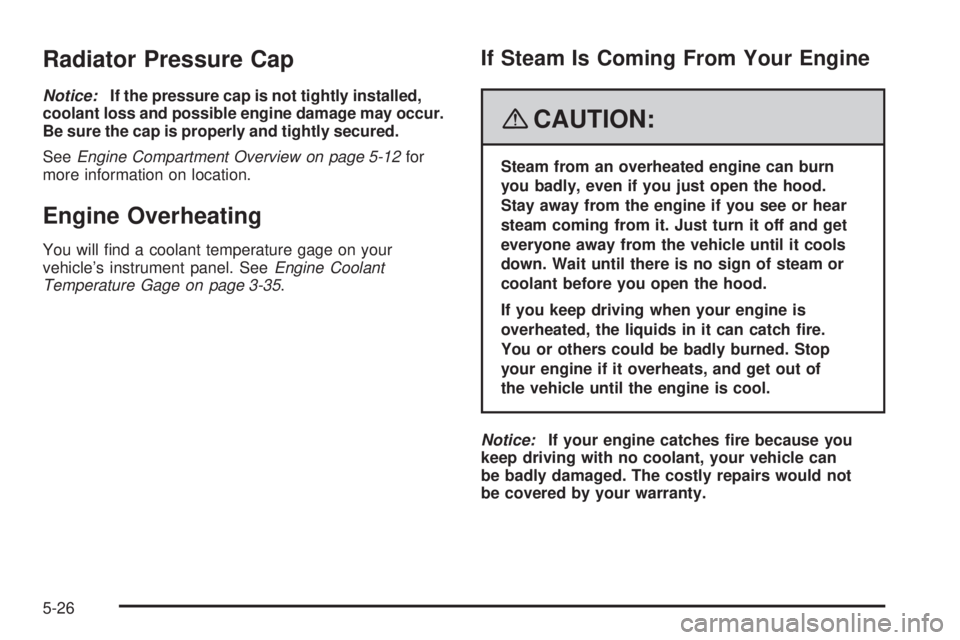
Radiator Pressure Cap
Notice:If the pressure cap is not tightly installed,
coolant loss and possible engine damage may occur.
Be sure the cap is properly and tightly secured.
SeeEngine Compartment Overview on page 5-12for
more information on location.
Engine Overheating
You will �nd a coolant temperature gage on your
vehicle’s instrument panel. SeeEngine Coolant
Temperature Gage on page 3-35.
If Steam Is Coming From Your Engine
{CAUTION:
Steam from an overheated engine can burn
you badly, even if you just open the hood.
Stay away from the engine if you see or hear
steam coming from it. Just turn it off and get
everyone away from the vehicle until it cools
down. Wait until there is no sign of steam or
coolant before you open the hood.
If you keep driving when your engine is
overheated, the liquids in it can catch �re.
You or others could be badly burned. Stop
your engine if it overheats, and get out of
the vehicle until the engine is cool.
Notice:If your engine catches �re because you
keep driving with no coolant, your vehicle can
be badly damaged. The costly repairs would not
be covered by your warranty.
5-26
Page 242 of 368
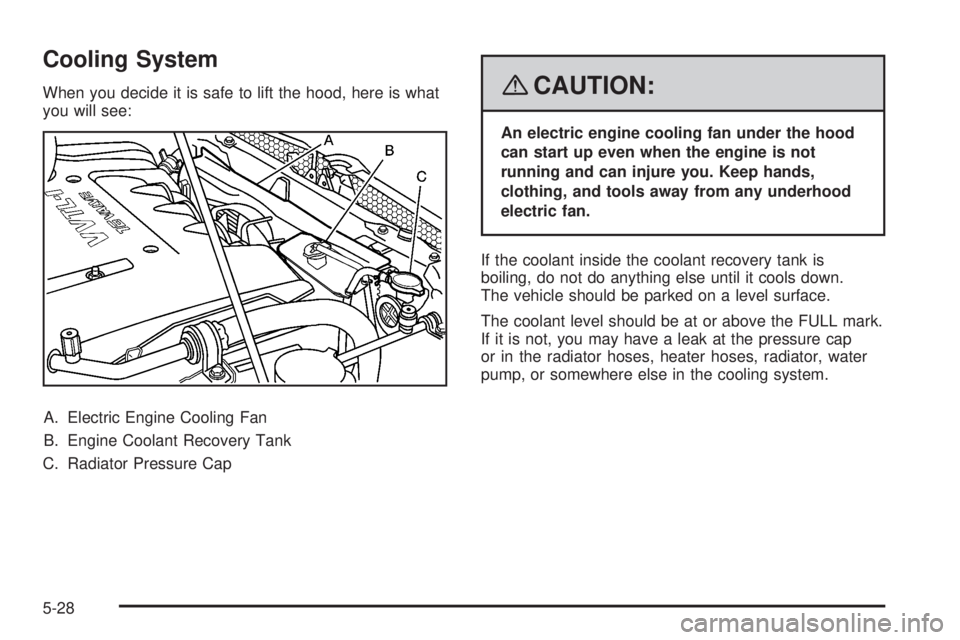
Cooling System
When you decide it is safe to lift the hood, here is what
you will see:
A. Electric Engine Cooling Fan
B. Engine Coolant Recovery Tank
C. Radiator Pressure Cap{CAUTION:
An electric engine cooling fan under the hood
can start up even when the engine is not
running and can injure you. Keep hands,
clothing, and tools away from any underhood
electric fan.
If the coolant inside the coolant recovery tank is
boiling, do not do anything else until it cools down.
The vehicle should be parked on a level surface.
The coolant level should be at or above the FULL mark.
If it is not, you may have a leak at the pressure cap
or in the radiator hoses, heater hoses, radiator, water
pump, or somewhere else in the cooling system.
5-28
Page 243 of 368
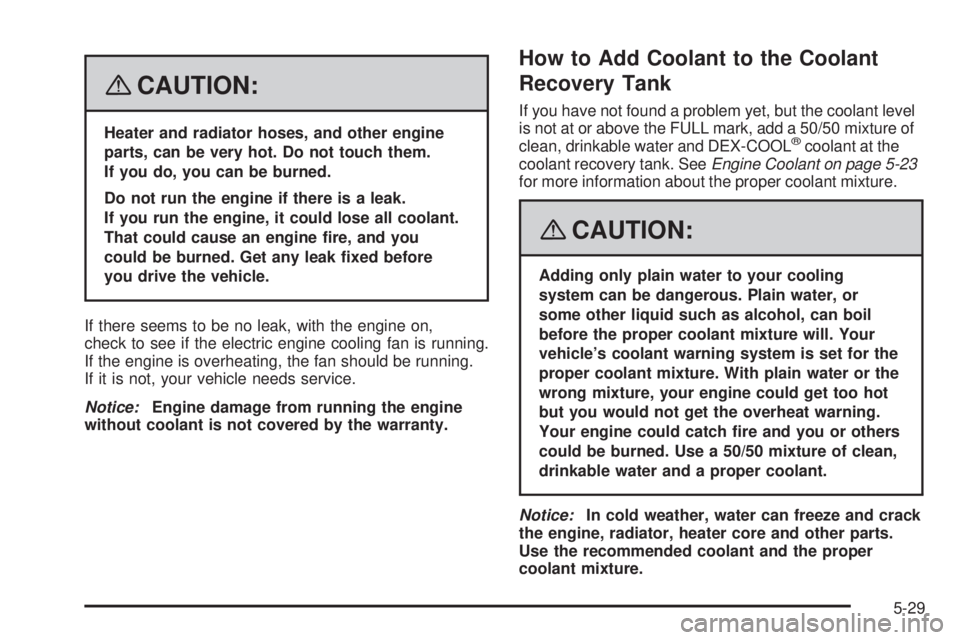
{CAUTION:
Heater and radiator hoses, and other engine
parts, can be very hot. Do not touch them.
If you do, you can be burned.
Do not run the engine if there is a leak.
If you run the engine, it could lose all coolant.
That could cause an engine �re, and you
could be burned. Get any leak �xed before
you drive the vehicle.
If there seems to be no leak, with the engine on,
check to see if the electric engine cooling fan is running.
If the engine is overheating, the fan should be running.
If it is not, your vehicle needs service.
Notice:Engine damage from running the engine
without coolant is not covered by the warranty.
How to Add Coolant to the Coolant
Recovery Tank
If you have not found a problem yet, but the coolant level
is not at or above the FULL mark, add a 50/50 mixture of
clean, drinkable water and DEX-COOL
®coolant at the
coolant recovery tank. SeeEngine Coolant on page 5-23
for more information about the proper coolant mixture.
{CAUTION:
Adding only plain water to your cooling
system can be dangerous. Plain water, or
some other liquid such as alcohol, can boil
before the proper coolant mixture will. Your
vehicle’s coolant warning system is set for the
proper coolant mixture. With plain water or the
wrong mixture, your engine could get too hot
but you would not get the overheat warning.
Your engine could catch �re and you or others
could be burned. Use a 50/50 mixture of clean,
drinkable water and a proper coolant.
Notice:In cold weather, water can freeze and crack
the engine, radiator, heater core and other parts.
Use the recommended coolant and the proper
coolant mixture.
5-29
Page 244 of 368
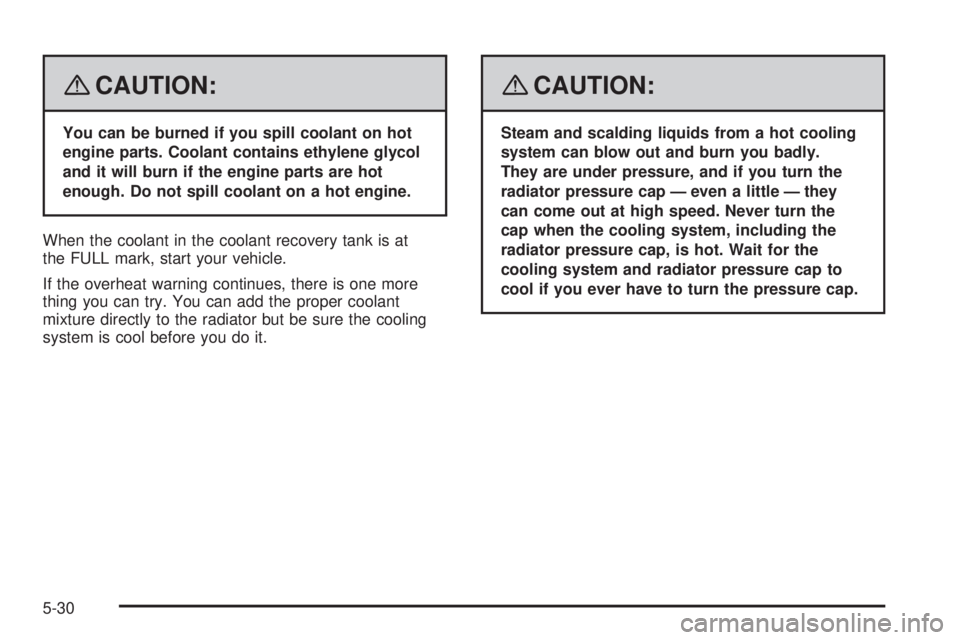
{CAUTION:
You can be burned if you spill coolant on hot
engine parts. Coolant contains ethylene glycol
and it will burn if the engine parts are hot
enough. Do not spill coolant on a hot engine.
When the coolant in the coolant recovery tank is at
the FULL mark, start your vehicle.
If the overheat warning continues, there is one more
thing you can try. You can add the proper coolant
mixture directly to the radiator but be sure the cooling
system is cool before you do it.
{CAUTION:
Steam and scalding liquids from a hot cooling
system can blow out and burn you badly.
They are under pressure, and if you turn the
radiator pressure cap — even a little — they
can come out at high speed. Never turn the
cap when the cooling system, including the
radiator pressure cap, is hot. Wait for the
cooling system and radiator pressure cap to
cool if you ever have to turn the pressure cap.
5-30
Page 245 of 368

How to Add Coolant to the Radiator
1. You can remove the radiator pressure cap when
the cooling system, including the radiator pressure
cap and upper radiator hose, is no longer hot.
Turn the pressure cap slowly counterclockwise until
it �rst stops. Do not press down while turning the
pressure cap.
If you hear a hiss, wait for that to stop. A hiss
means there is still some pressure left.
2. Then keep turning the pressure cap, but now push
down as you turn it. Remove the pressure cap.3. Fill the radiator with the proper coolant mixture, up
to the base of the �ller neck. SeeEngine Coolant
on page 5-23for more information about the proper
coolant mixture.
5-31
Page 246 of 368

4. Then �ll the coolant recovery tank to the
FULL mark.
5. Put the cap back on the coolant recovery tank,
but leave the radiator pressure cap off.6. Start the engine and let it run until you can feel the
upper radiator hose getting hot. Watch out for the
engine cooling fan.
7. By this time, the coolant level inside the radiator �ller
neck may be lower. If the level is lower, add more of
the proper coolant mixture through the �ller neck until
the level reaches the base of the �ller neck.
8. Then replace the pressure cap. At any time during
this procedure if coolant begins to �ow out of the
�ller neck, reinstall the pressure cap. Be sure
the ears on the pressure cap are in line with the
vent tube.
5-32
Page 248 of 368
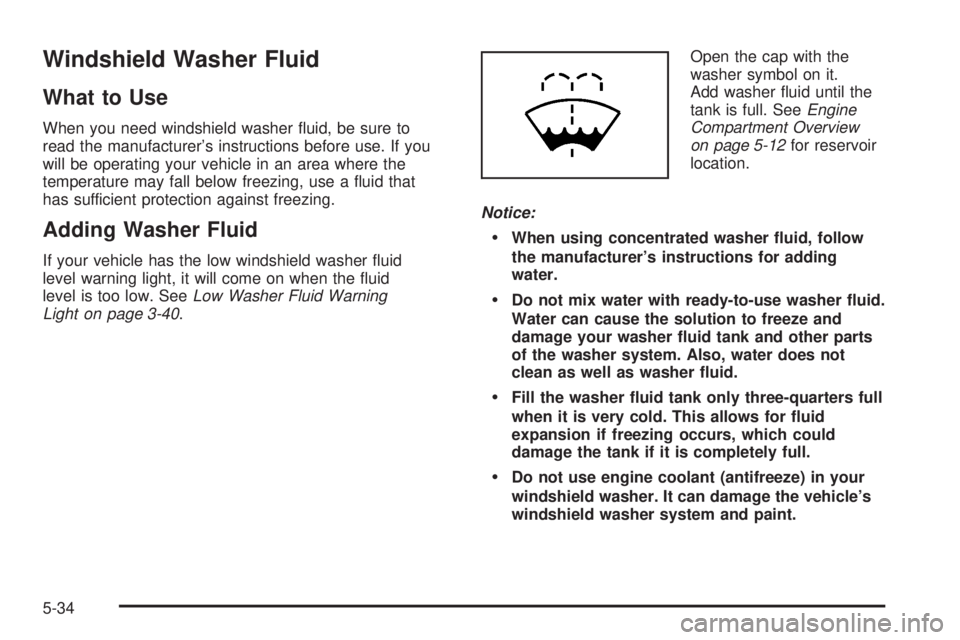
Windshield Washer Fluid
What to Use
When you need windshield washer �uid, be sure to
read the manufacturer’s instructions before use. If you
will be operating your vehicle in an area where the
temperature may fall below freezing, use a �uid that
has sufficient protection against freezing.
Adding Washer Fluid
If your vehicle has the low windshield washer �uid
level warning light, it will come on when the �uid
level is too low. SeeLow Washer Fluid Warning
Light on page 3-40.Open the cap with the
washer symbol on it.
Add washer �uid until the
tank is full. SeeEngine
Compartment Overview
on page 5-12for reservoir
location.
Notice:
When using concentrated washer �uid, follow
the manufacturer’s instructions for adding
water.
Do not mix water with ready-to-use washer �uid.
Water can cause the solution to freeze and
damage your washer �uid tank and other parts
of the washer system. Also, water does not
clean as well as washer �uid.
Fill the washer �uid tank only three-quarters full
when it is very cold. This allows for �uid
expansion if freezing occurs, which could
damage the tank if it is completely full.
Do not use engine coolant (antifreeze) in your
windshield washer. It can damage the vehicle’s
windshield washer system and paint.
5-34
Page 323 of 368
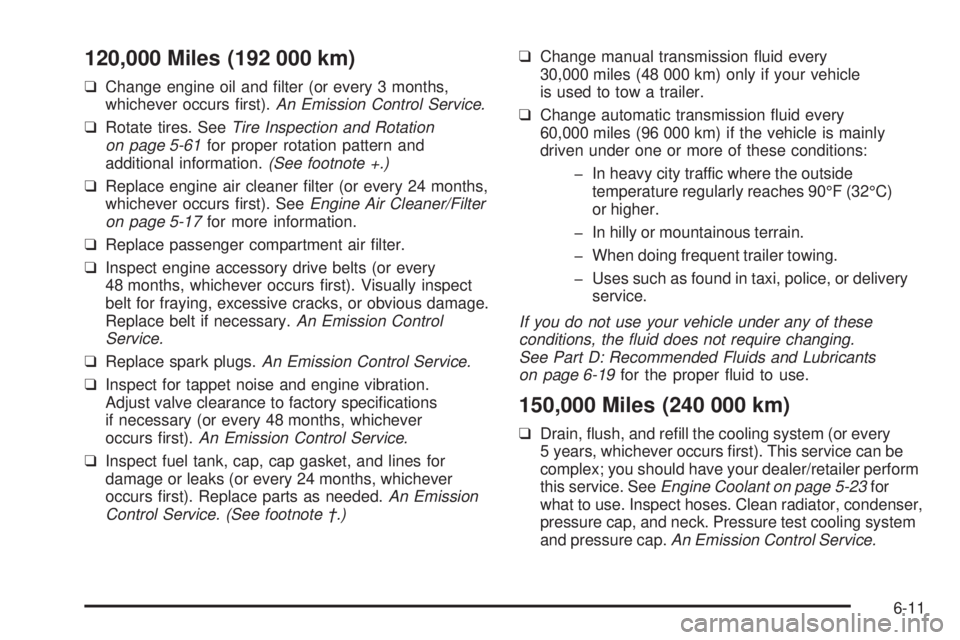
120,000 Miles (192 000 km)
❑Change engine oil and �lter (or every 3 months,
whichever occurs �rst).An Emission Control Service.
❑Rotate tires. SeeTire Inspection and Rotation
on page 5-61for proper rotation pattern and
additional information.(See footnote +.)
❑Replace engine air cleaner �lter (or every 24 months,
whichever occurs �rst). SeeEngine Air Cleaner/Filter
on page 5-17for more information.
❑Replace passenger compartment air �lter.
❑Inspect engine accessory drive belts (or every
48 months, whichever occurs �rst). Visually inspect
belt for fraying, excessive cracks, or obvious damage.
Replace belt if necessary.An Emission Control
Service.
❑Replace spark plugs.An Emission Control Service.
❑Inspect for tappet noise and engine vibration.
Adjust valve clearance to factory speci�cations
if necessary (or every 48 months, whichever
occurs �rst).An Emission Control Service.
❑Inspect fuel tank, cap, cap gasket, and lines for
damage or leaks (or every 24 months, whichever
occurs �rst). Replace parts as needed.An Emission
Control Service. (See footnote †.)❑Change manual transmission �uid every
30,000 miles (48 000 km) only if your vehicle
is used to tow a trailer.
❑Change automatic transmission �uid every
60,000 miles (96 000 km) if the vehicle is mainly
driven under one or more of these conditions:
� In heavy city traffic where the outside
temperature regularly reaches 90°F (32°C)
or higher.
� In hilly or mountainous terrain.
� When doing frequent trailer towing.
� Uses such as found in taxi, police, or delivery
service.
If you do not use your vehicle under any of these
conditions, the fluid does not require changing.
See Part D: Recommended Fluids and Lubricants
on page 6-19for the proper �uid to use.
150,000 Miles (240 000 km)
❑Drain, �ush, and re�ll the cooling system (or every
5 years, whichever occurs �rst). This service can be
complex; you should have your dealer/retailer perform
this service. SeeEngine Coolant on page 5-23for
what to use. Inspect hoses. Clean radiator, condenser,
pressure cap, and neck. Pressure test cooling system
and pressure cap.An Emission Control Service.
6-11
Page 324 of 368

Part B: Owner Checks and Services
Listed in this part are owner checks and services
which should be performed at the intervals speci�ed to
help ensure the safety, dependability and emission
control performance of your vehicle.
Be sure any necessary repairs are completed at once.
Whenever any �uids or lubricants are added to your
vehicle, make sure they are the proper ones, as shown
in Part D.
At Each Fuel Fill
It is important to perform these underhood checks at
each fuel fill.
Engine Oil Level Check
Notice:It is important to check the engine oil
regularly and keep it at the proper level. Failure to
keep the engine oil at the proper level can cause
damage to the engine not covered by your warranty.
Check the engine oil level and add the proper oil if
necessary. SeeEngine Oil on page 5-13.
Engine Coolant Level Check
Check the engine coolant level and add DEX-COOL®
coolant mixture if necessary. SeeEngine Coolant
on page 5-23.
Windshield Washer Fluid Level Check
Check the windshield washer �uid level in the windshield
washer �uid reservoir and add the proper �uid if
necessary. SeeWindshield Washer Fluid on page 5-34.
Hood Latch Operation Check
Pull the primary hood latch release handle inside the
vehicle. The secondary latch should keep the hood from
opening all the way when the primary latch is released.
Make sure the hood closes �rmly. SeeHood Release
on page 5-10.
6-12
Page 331 of 368

Part D: Recommended Fluids and
Lubricants
Fluids and lubricants identi�ed below by name, part
number, or speci�cation can be obtained from your
dealer/retailer.
Usage Fluid/Lubricant
Engine OilEngine oil which meets
GM Standard GM6094M
and displays the American
Petroleum Institute Certi�ed for
Gasoline Engines starburst symbol.
To determine the proper viscosity for
your vehicle’s engine, seeEngine
Oil on page 5-13.
Engine Coolant50/50 mixture of clean, drinkable
water and use only DEX-COOL
®
Coolant. SeeEngine Coolant on
page 5-23.
Hydraulic
Brake/Clutch
SystemDelco
®Supreme 11 Brake Fluid or
equivalent DOT-3 brake �uid.
Usage Fluid/Lubricant
Windshield
Washer SolventOptikleen
®Washer Solvent.
Power Steering
SystemDEXRON
®-VI Automatic
Transmission Fluid.
Manual
TransmissionGM Goodwrench
®Synthetic
Manual Transmission Fluid
(GM Part No. U.S. 12346190,
in Canada 10953477 — 1 quart)
or SAE 75W-90 GL-5 gear oil.
Automatic
TransmissionUse only T-IV Automatic
Transmission Fluid
(GM Part No. U.S. 88900925,
in Canada 22689186).
Key Lock
CylindersMulti-Purpose Lubricant, Superlube
(GM Part No. U.S. 12346241,
in Canada 10953474).
Manual
Transmission
Shift LinkageChassis Lubricant
(GM Part No. U.S. 12377985, in
Canada 88901242) or lubricant
meeting requirements of NLGI #2,
Category LB or GC-LB.
6-19